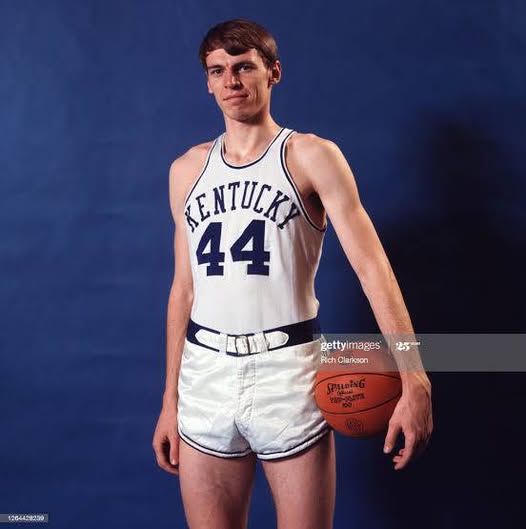More than five decades have passed since Dan Issel last suited up for the University of Kentucky, yet his name still sits atop the record books, untouched and unrivaled. With 2,138 career points amassed over just three seasons from 1967 to 1970, Issel’s reign as Kentucky’s all-time leading scorer remains one of the most enduring records in college basketball history. The question echoes throughout Big Blue Nation: Will anyone ever surpass Dan Issel?
To answer that, one must understand not only the record itself, but also the man, the era, and the ever-shifting landscape of college basketball.
The Legend of Dan Issel
Dan Issel was a force of nature at Kentucky. Standing 6-foot-9 and blessed with a smooth shooting touch, a relentless motor, and a scorer’s mentality, Issel played under legendary coach Adolph Rupp. In an era without the three-point line, without the benefits of modern training, and without freshmen being allowed to play varsity, Issel’s scoring feats are all the more astonishing.
From 1967–1970, Issel averaged 25.7 points per game and 12.2 rebounds. He recorded 64 double-doubles in 83 games. He still holds the Kentucky single-season scoring record with 948 points during the 1969–70 campaign—a mark that would be nearly impossible to match today even with extended seasons and postseason runs.
Issel’s 2,138-point total came at a time when players had fewer games and no shot at early pro exposure. He was consistent, durable, and dominant in the paint and from midrange. Perhaps what makes his scoring record so mythical is not just the number itself—but the message it sends: this was a player built for greatness, in the truest sense of the word.
Why His Record Still Stands
There have been phenomenal scorers who wore the blue and white after Issel: Kenny Walker, Jamal Mashburn, Antoine Walker, Tony Delk, Malik Monk, and more recently, Oscar Tshiebwe and Antonio Reeves. And yet, none of them came remotely close.
Here’s why Issel’s record has become so enduring:
- Freshmen Ineligibility: Issel couldn’t play varsity as a freshman. If he had, he likely would’ve surpassed 2,500 points. Modern players can play four seasons, but few do.
- Early Departures: Modern college basketball is a stepping stone to the NBA. Players like John Wall, Anthony Davis, and De’Aaron Fox were one-and-done stars. The era of four-year college careers for elite scorers is almost extinct.
- Scoring Distribution: Kentucky is often loaded with talent. Players share the ball, and few average more than 15–18 points per game. Issel was the offensive centerpiece of his team. That’s rare in the Calipari/Pope eras.
- Shorter College Seasons: While modern teams might play more postseason games, the standard college basketball season remains relatively short—about 35–40 games max, including March Madness.
- No Three-Point Line: Issel did all of this without a three-point shot. His points came from twos and free throws. It’s fair to speculate that if the arc had existed, he would’ve blown past 2,500 points.
The Modern Scorers Who’ve Come Closest
A handful of players in the modern era have raised eyebrows and brought whispers of “Could this be the one?”
- Kenny Walker (1982–1986) came closest among post-Issel players, finishing with 2,080 points in four years. “Sky” Walker played all four seasons, and his steady progression nearly pushed him past Issel.
- Tony Delk (1992–1996), a Final Four MOP and sharpshooter, hit 1,890 points. Delk had the benefit of the three-point line and played in a high-tempo offense, but scoring was more balanced during his era.
- Oscar Tshiebwe (2021–2023)—the rebounding machine and 2022 National Player of the Year—put up huge numbers but played only two full seasons. He finished with 1,117 points at UK.
- Antonio Reeves (2022–2024), though a prolific scorer, transferred in as a junior and didn’t have enough time or usage to sniff 2,000 points, ending with 1,163.
None of these came particularly close. And that tells you everything.
The Transfer Portal and NIL Era: A Threat or a Hope?
Some believe that the new landscape—ushered in by the transfer portal and NIL—could ironically help break Issel’s record. Why?
- More Seniors Staying: Players now have financial incentives to stay in school longer. A four-year player who can profit from his brand may choose college over a late second-round NBA risk.
- Mid-Major Scorers Moving Up: High-volume scorers at smaller programs are transferring into Kentucky. If one stays for two or three years and scores efficiently, the cumulative total could challenge Issel.
However, there’s still a catch: players who transfer often don’t play four full years at Kentucky. The institutional loyalty that allowed Issel to spend his entire varsity career in Lexington is increasingly rare.
The Coach Pope Era: A New Opportunity?
Mark Pope’s appointment as head coach has infused new hope and energy into the Kentucky program. Pope values shooting, spacing, and modern offensive schemes that could allow for high individual scoring outputs.
Under Pope, it’s possible we’ll see guards or wings given a longer leash to score. Jasper Johnson, Travis Perry, and other future recruits could flourish in such systems. But will they stay four years? That’s the million-dollar question.
With the right player—a four-year star who avoids injury, fits Pope’s system, and emerges as a go-to scorer—there might be a path. But it would require something nearly perfect.
What Would It Take to Break the Record?
Let’s crunch the numbers.
To surpass Issel’s 2,138 career points, a player would need to average:
- 535 points per season over four years, or
- Roughly 15.3 points per game, assuming 35 games per year.
That seems doable. But here’s the twist:
- Few players stay four years.
- Those who do often aren’t the team’s top scorer every year.
- Injuries, role changes, or coaching shifts derail most long-term scoring arcs.
To break the record in three years, like Issel did, a player would need to average 24.2 points per game for three full seasons. The last Kentucky player to average even 20+ for a season was Malik Monk in 2016–17. You can see the challenge.
The Cultural Weight of the Record
Dan Issel isn’t just Kentucky’s top scorer; he’s a symbol of a bygone era. He’s a bridge between Adolph Rupp and the modern UK program. His number (44) is retired. His records are revered. He later became an ABA/NBA star and is enshrined in the Basketball Hall of Fame.
Every Kentucky fan knows the name. For those who bleed blue, Issel represents consistency, loyalty, production, and excellence. His legacy is wrapped in tradition—and for many, untouchability.
To break the record wouldn’t just require buckets—it would require an icon. A legend in the making. Someone who could rival Issel not only in stats but in soul.
Could Jasper Johnson Be the One?
All eyes now turn to the future, and one of those bright lights is Jasper Johnson, the 5-star combo guard from Kentucky who recently committed to the Wildcats and is already turning heads with Team USA.
Johnson has the pedigree, the smooth game, the modern range, and perhaps the long-term potential to be the face of the program. If he stays for multiple years—an increasing possibility with NIL—he could push the conversation forward.
It’s far too early to speculate, but Johnson represents the type of player who could get it done. He’s confident. He scores on all three levels. And if Pope builds around him? Anything’s possible.
A Record Made to Last—But Records Were Made to Be Broken
Dan Issel’s name has ruled Kentucky’s scoring history for over 50 years. And truthfully? It may last 50 more.
It is a perfect storm of era, opportunity, and excellence that created his record. Today’s players face new obstacles—NBA allure, limited usage, shared star roles—but also new opportunities, like NIL and extended eligibility.
Whether the record falls in our lifetime remains to be seen. But for now, Dan Issel stands not just as a scorer—but as a reminder of what once was, and what might one day be again.



